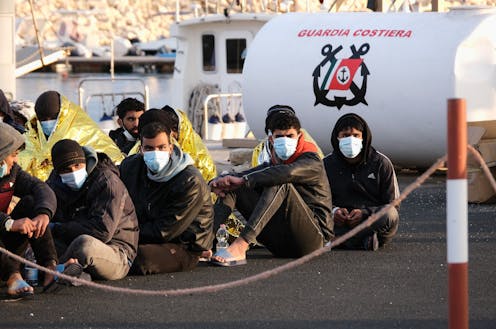
The sinking of a boat off the coast of Greece transformed World Refugee Day, celebrated the June 20, into a day of mourning. There were an estimated 750 people on board, 70 were confirmed to have died and only 104 were rescued from the wreckage – leaving many unaccounted for.
In March, another shipwreck, this time off Italy, left nearly 100 people dead. In almost all cases, these are people fleeing violence, war and misery.
A recent UN report indicates that the number of forcibly displaced people in the world reached a record 108 million in 2022, of whom more than 35 million are refugees in other countries.
The figures, driven in part by the war in Ukraine, even exceed those during the Mediterranean refugee crisis between 2015 and 2016. At that time, the migration crisis achieved a media presence rarely seen before. One need only recall the image of Aylan Kurdi, the Syrian boy who drowned on a Turkish beach in September 2015, which became a symbol of the migration drama.
Migration in Southern Europe
As has been the case this year with the shipwrecks referred to above, the focus of this crisis was in southern Europe. To be precise, the largest volume of arrivals moved from Greece (the eastern Mediterranean, in 2015), to Italy (central Mediterranean, 2016 and 2017) and, finally, to Spain (western Mediterranean, in 2018). In June of that year, in Spain, the arrival of the Aquarius boat marked a turning point.
These countries are the main gateways for migrants to enter the European Union. One of the demands made by these countries, and which is precisely behind the declaration of a migration emergency in Italy, is the need for migration management at the European level, as the burden of managing arrivals falls almost exclusively on the national authorities, when it is a European challenge.
This is compounded by the economic situation of these three countries. At the time of the humanitarian refugee crisis from 2014 onwards, these countries were still recovering from the harsh adjustment measures resulting from the economic and financial crisis that began in 2008. Their challenges are therefore particularly complex.
Hate in the media
This migratory reality has coincided – not accidentally – with the rise of discourses of rejection. These discourses have been popularised through social networks and are closely related to the rise to power of openly anti-immigration parties, such as Vox in Spain or Matteo Salvini’s Lega and Giorgia Meloni’s Fratelli d'Italia in Italy.
But the phenomenon of racism and rejection of migrants is very complex, and is often related to the representation of these people in the media. This is something that academic research has been analysing for a long time, having observed that this representation tends to be stereotypical, negative and insufficient.
With these premises, a team from the Audiovisual Content Observatory at the University of Salamanca has led a consortium together with researchers from the University of Milan (Italy) and the Aristotelian University of Thessaloniki (Greece), to understand the reality of media representation of migration in these countries, paying special attention to the hate speech that migrants and refugees receive. This project has recently resulted in a book, entitled Migrants and Refugees in Southern Europe Beyond the News Stories: Photographs, Hate and Journalists’ Perceptions.
In it, the focus is placed on three main issues: the photographs used by the mainstream media when covering migration phenomena, the presence of racist and xenophobic hate speech on Twitter and YouTube, and the opinions of journalists specialising in migration.
Observations of concern
Firstly, the four predominant frames of representation of migrants in mainstream media in southern Europe were identified: normalisation, victimisation, social burden and threat.
It was found that mainstream media in Mediterranean countries are dominated by those frames that depict migrants as victims or as a burden. Moreover, negative frames (both those portraying migrants as a burden and those identifying them as a threat) have grown significantly between 2014 and 2019. Although the pattern is shared across the three countries, it is the Greek media that make a substantially more negative representation of migration through their frames.
On the other hand, the presence of hate speech on Twitter and YouTube, measured through computational techniques, appears to be small in absolute terms, and no very significant increase is observed over the last few years.
However, a close analysis of the underlying themes of these messages shows that hatred towards migrants is mainly argued through their association with criminality, terrorism and social spending. For example, fake news or incorrect scoops that declare –before having checked it– that the perpetrator of a crime is of foreign origin, or articles indicating that migrants are more likely to get more social benefits than locals. These narratives are often supported by this information then gets circulated online, fuelling unfounded but deeply embedded fears.
Against this backdrop, journalists specialising in the field are concerned. Although they defend their actions and their professionalism, they also recognise that there are bad practices and limitations, such as precariousness or lack of time, which prevent a more objective, accurate and humane coverage of migratory phenomena. There is a certain division between those who place journalistic practice above all else and those who defend the humanity and human rights of migrants and refugees as priority values.
A final element that helps to understand the real effects of these representations is that hate crimes recorded in recent years are steadily increasing in these three countries, but also in most Western countries, as indicated by data collected by the Organisation for Security and Cooperation in Europe.
How to reverse this situation
In order to achieve a more humane representation of migration in the media, we propose three strategies:
Greater awareness and sensitisation about these issues by different actors, both journalists and media professionals as well as audiences, including users of social platforms.
More evidence-based journalism, more verification and more in-depth reporting.
More personal stories, more participation of the protagonists, the displaced themselves, and more narratives that seek to identify with these people, avoiding their stigmatisation.
This is necessary to tell the whole story, so as not to limit migrants to a mass in front of our borders. The migration crisis caused by the Russian invasion of Ukraine shows that there is another way not only to represent migrants and refugees, but also to respond on an institutional and human level. May we learn lessons for better responses to current and future migration challenges.
David Blanco-Herrero receives funding from the Ministry of Universities under the FPU programme (ref. FPU18/01455).
Francisco Javier Jiménez Amores receives funding from the Junta de Castilla y León and the European Social Fund through a grant for the recruitment of research trainees.
Patricia Sánchez-Holgado receives research funding from the Spanish Foundation for Science and Technology FECYT.
This article was originally published on The Conversation. Read the original article.







